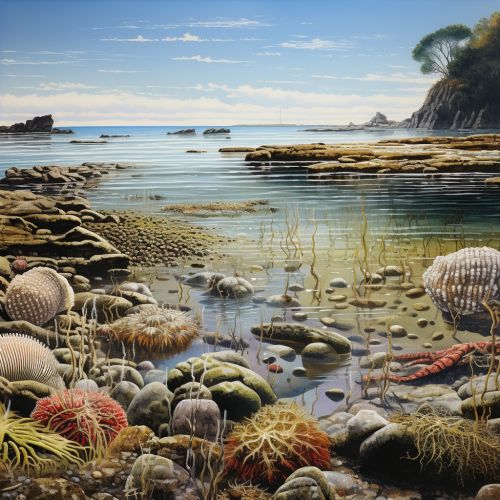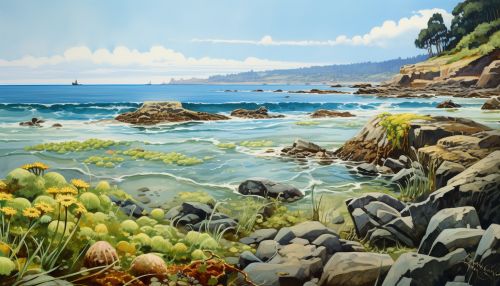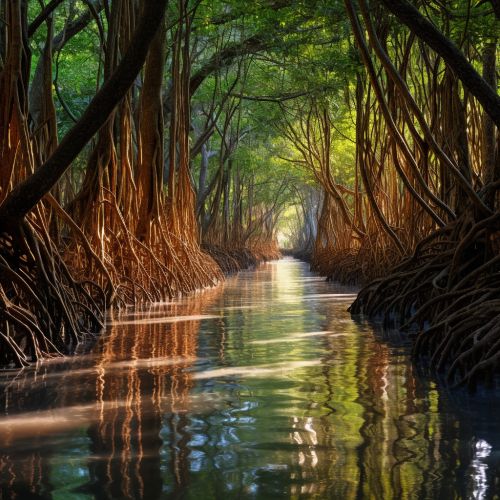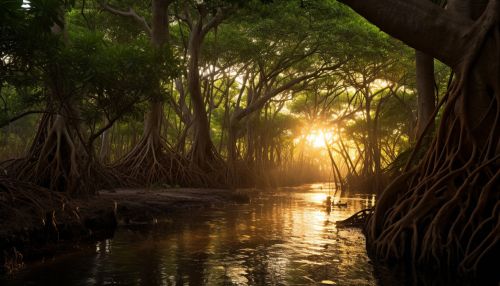The Ecology of Intertidal Zones and Coastal Ecosystems
Introduction
The ecology of intertidal zones and coastal ecosystems is a complex and fascinating field of study. These areas, where the ocean meets the land, are home to a diverse array of organisms and are shaped by a unique set of environmental factors. Understanding the dynamics of these ecosystems is crucial for conservation efforts and for predicting the impacts of climate change.
Intertidal Zones
Intertidal zones, also known as the littoral zone, are areas of the shoreline that are exposed to the air at low tide and submerged at high tide. These zones are typically divided into four subzones: the splash zone, the high intertidal zone, the mid intertidal zone, and the low intertidal zone. Each of these subzones is characterized by a distinct set of species and environmental conditions.
Splash Zone
The splash zone is the highest area of the intertidal zone, only covered by water during storms or extremely high tides. Organisms in this zone, such as lichens and periwinkles, must be able to withstand desiccation, or drying out, as well as exposure to sunlight and temperature extremes.
High Intertidal Zone
The high intertidal zone is covered by water only during high tide. Species in this zone, such as barnacles and mussels, have adaptations that allow them to cling tightly to rocks to prevent being swept away by waves. They also have mechanisms to prevent desiccation during periods of exposure to air.
Mid Intertidal Zone
The mid intertidal zone is regularly exposed and submerged by the tide, making it a highly dynamic environment. Organisms in this zone, such as sea anemones and starfish, must be able to tolerate a wide range of conditions, including changes in temperature, salinity, and moisture.
Low Intertidal Zone
The low intertidal zone is the area that is exposed only during the lowest tides and is submerged most of the time. This zone is home to a diverse array of marine life, including seaweeds, mollusks, and fish, which take advantage of the relatively stable conditions.


Coastal Ecosystems
Coastal ecosystems, which include estuaries, salt marshes, and Mangroves|mangrove forests, are areas where freshwater from the land mixes with saltwater from the sea. These ecosystems are highly productive and support a rich diversity of species.
Estuaries
Estuaries are bodies of water where rivers meet the sea, and the freshwater and saltwater mix. This brackish water environment is rich in nutrients, making estuaries one of the most productive ecosystems on Earth. They serve as important nurseries for many species of fish and shellfish.
Salt Marshes
Salt marshes are coastal wetlands that are flooded and drained by salt water brought in by the tides. They are characterized by salt-tolerant vegetation, such as grasses and shrubs. Salt marshes provide important habitat for a variety of wildlife and also serve as a buffer against coastal erosion.
Mangrove Forests
Mangrove forests are coastal ecosystems that are characterized by the presence of mangrove trees, which are able to tolerate the salty conditions. Mangroves provide important habitat for a variety of species, including many species of fish and birds. They also play a crucial role in carbon sequestration and in protecting coastlines from erosion and storm surges.


Ecological Processes
The ecology of intertidal zones and coastal ecosystems is shaped by a variety of processes, including tidal range, wave action, and nutrient cycling. These processes influence the distribution and abundance of species, as well as the physical characteristics of these ecosystems.
Tidal Range
Tidal range, or the difference in height between high tide and low tide, is a key factor that influences the ecology of intertidal zones. Areas with a large tidal range have a wider intertidal zone and a greater diversity of habitats compared to areas with a small tidal range.
Wave Action
Wave action is another important factor that shapes these ecosystems. In areas with high wave action, organisms must be able to withstand the physical force of the waves. This can influence the types of species that are able to survive in these areas.
Nutrient Cycling
Nutrient cycling is a crucial process in coastal ecosystems. Nutrients from the land, such as nitrogen and phosphorus, are carried to the coast by rivers. These nutrients support the high productivity of these ecosystems, but can also lead to problems such as eutrophication if levels are too high.
Conservation and Threats
Intertidal zones and coastal ecosystems are facing a variety of threats, including climate change, pollution, and habitat destruction. These threats can lead to loss of biodiversity, changes in ecosystem function, and impacts on human communities that rely on these ecosystems for their livelihoods.
Climate Change
Climate change is a major threat to these ecosystems. Rising sea levels can lead to loss of habitat, while increasing temperatures can alter the distribution of species. Ocean acidification, a result of increased carbon dioxide in the atmosphere, can also have detrimental effects on marine life, particularly species with calcium carbonate shells or skeletons.
Pollution
Pollution, particularly from agricultural runoff and industrial waste, can have serious impacts on these ecosystems. Nutrient pollution can lead to eutrophication, a process that depletes oxygen levels in the water and can lead to the death of marine life. Oil spills and plastic pollution are also significant threats.
Habitat Destruction
Habitat destruction, often as a result of coastal development, is another major threat. This can lead to loss of important habitats, such as mangrove forests and salt marshes, and can also increase the vulnerability of coastlines to erosion and storm surges.
Conclusion
The ecology of intertidal zones and coastal ecosystems is a complex and dynamic field of study. These ecosystems are home to a diverse array of species and are shaped by a unique set of environmental factors. However, they are also facing a variety of threats, including climate change, pollution, and habitat destruction. Understanding and addressing these threats is crucial for the conservation of these important ecosystems.
